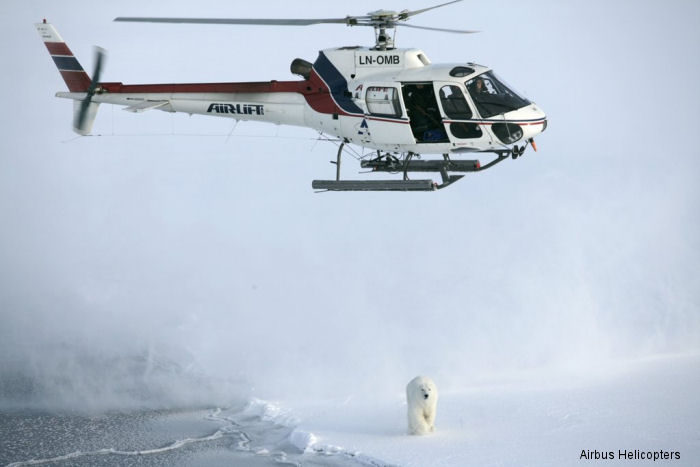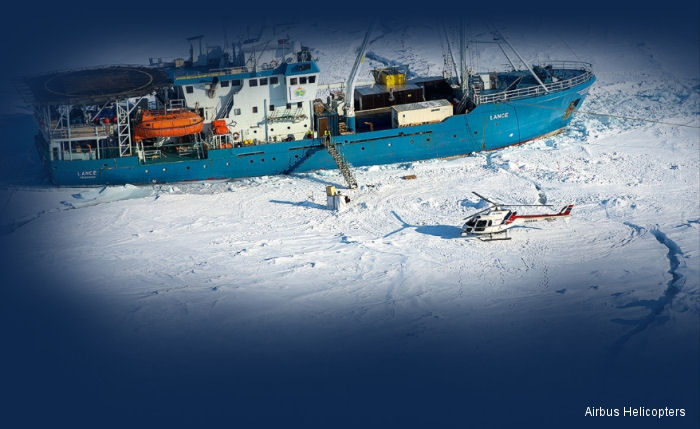Airbus Helicopters, November 30, 2015 - It is well known that satellites are collecting crucial data for climate research. But did you know that helicopters are also used to investigate global warming?
Sretching out beneath the helicopter is a seemingly endless sheet of Arctic ice. Suddenly, a polar bear appears in the whirled up snow.
The helicopter flies towards the animal. Hearing its blades, the bear tries to escape. But the helicopter continues to sink slowly down as the side door slides open.
A passenger appears, aiming a rifle at the bear. A shot cracks above the noise of the rotors. The polar bear is hit but continues to run for a few more seconds before collapsing onto the ice.
But the animal is not dead. It is just unconscious, shot with a tranquiliser rifle so that the scientists on board the helicopter could take blood samples and DNA probes to examine the grade of pollution in the arctic.
Trapped in the cold
The operator of the helicopter is Airlift, which has been performing these data collection flights since 2011.
The Norwegian company uses Airbus Helicopters’ H125 (previously named AS350) machines. This operator offers different services for scientific missions in the Arctic and Antarctic, where they fly over ice fields with a torpedo-like device mounted under the helicopter. But here, nothing gets shot. The device is an electromagnetic measuring system that assesses the thickness of the sea ice.
The data collected by the Airbus Helicopters H125 rotorcraft is then validated against the findings of the CryoSat-2 satellite.
“We also have radars underneath the helicopter to record any changes to the glaciers,” explains Gunnar Svein Nordahl from Airlift. “For instance, we can see if they’ve moved or even sunk somewhat from the year before.” On these missions for the Norwegian Polar Institute, the crew is often stationed in the Antarctic for months at a time – at temperatures as low as -30°C.
On a mission in 2015, an ice breaker with 30 scientists and the H125 on board was deliberately frozen into the ice of the Antarctic. The mission was to explore, among other things, the drift of ice and the pollution of air, water and ice. Scientists and helicopter crew spent six months on the frozen ship.
“These missions can be very difficult,” says Nordahl. “But it is an important task, because the data we collect enables researchers to observe changes in the climate.”
Sretching out beneath the helicopter is a seemingly endless sheet of Arctic ice. Suddenly, a polar bear appears in the whirled up snow.
The helicopter flies towards the animal. Hearing its blades, the bear tries to escape. But the helicopter continues to sink slowly down as the side door slides open.
A passenger appears, aiming a rifle at the bear. A shot cracks above the noise of the rotors. The polar bear is hit but continues to run for a few more seconds before collapsing onto the ice.
But the animal is not dead. It is just unconscious, shot with a tranquiliser rifle so that the scientists on board the helicopter could take blood samples and DNA probes to examine the grade of pollution in the arctic.
Trapped in the cold
The operator of the helicopter is Airlift, which has been performing these data collection flights since 2011.
The Norwegian company uses Airbus Helicopters’ H125 (previously named AS350) machines. This operator offers different services for scientific missions in the Arctic and Antarctic, where they fly over ice fields with a torpedo-like device mounted under the helicopter. But here, nothing gets shot. The device is an electromagnetic measuring system that assesses the thickness of the sea ice.
The data collected by the Airbus Helicopters H125 rotorcraft is then validated against the findings of the CryoSat-2 satellite.
“We also have radars underneath the helicopter to record any changes to the glaciers,” explains Gunnar Svein Nordahl from Airlift. “For instance, we can see if they’ve moved or even sunk somewhat from the year before.” On these missions for the Norwegian Polar Institute, the crew is often stationed in the Antarctic for months at a time – at temperatures as low as -30°C.
On a mission in 2015, an ice breaker with 30 scientists and the H125 on board was deliberately frozen into the ice of the Antarctic. The mission was to explore, among other things, the drift of ice and the pollution of air, water and ice. Scientists and helicopter crew spent six months on the frozen ship.
“These missions can be very difficult,” says Nordahl. “But it is an important task, because the data we collect enables researchers to observe changes in the climate.”
AS350B2 Ecureuil LN-OMB ( Airlift AS )
See also |






